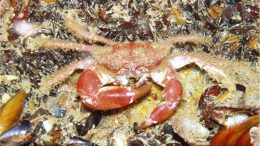In 1909 Russian scientist Sergey Zernov discovered a strange and lovely ecosystem in the Black Sea. Just above the sandy seafloor floated a field of red seaweed. Among the seaweed were animals — fish, sponges, worms, crayfish, and more — nearly all in various shades of red.
Scientists have since learned that this ecosystem hosts some 110 invertebrate species, 40 species of fish, and 30 species of algae. At its foundation are three crimson seaweeds, forming a vivid aquatic structure where biodiversity thrives.
Two of the three are in the genus Phyllophora (the third once was too, but now has a different name). While various species of this red seaweed grow around the world, it’s only in the Black Sea that they form vast fields. Other lifeforms have adapted to live among the Phyllophora, with red protective coloring for camouflage.
Zernov’s Phyllophora Field, named for its discoverer, occupies a large patch of the northwestern Black Sea. A second one, the Small Phyllophora Field, was discovered in 1957 near the shore of the Crimean Peninsula. Both are marine protected areas of Ukraine. And both now face unprecedented threats from Russian military aggression.
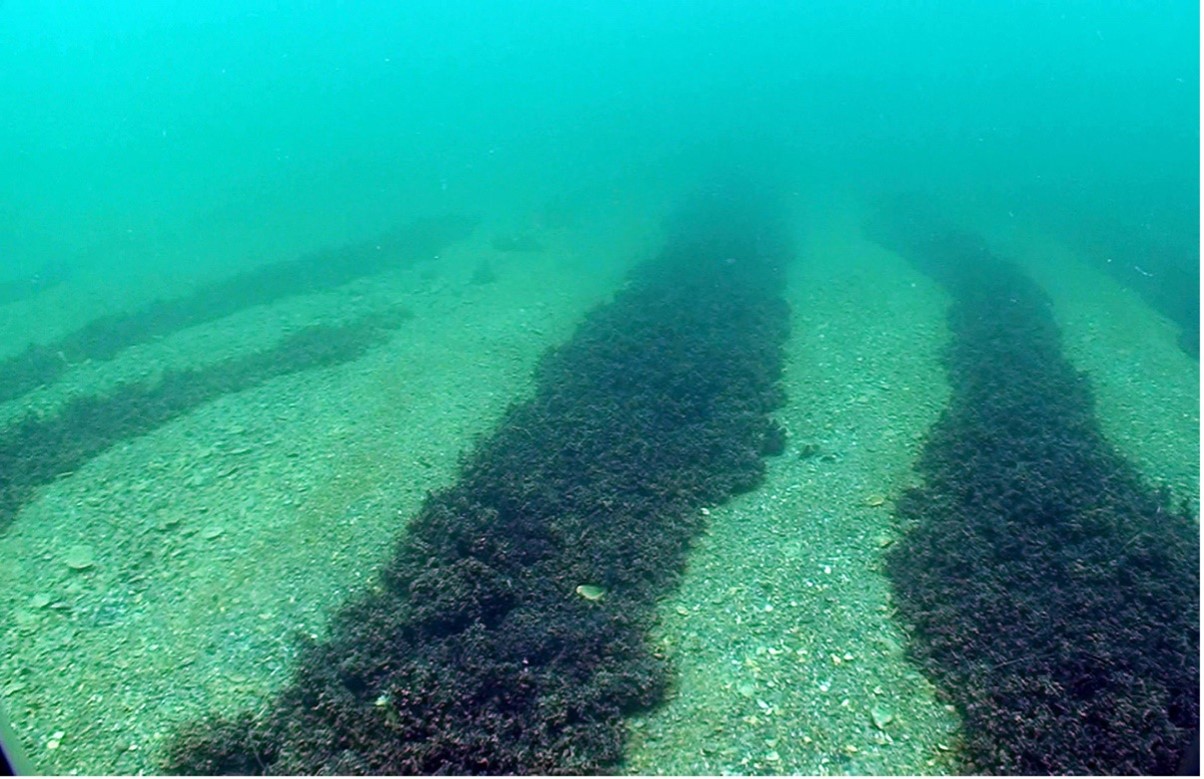
Russia’s 2014 invasion of Crimea, followed by its 2022 escalation into full-scale war, brought destructive pollution, noise, fires, and explosions to these delicate ecosystems. The war has also blocked scientists from visiting the Phyllophora fields, which were only just recovering from damage wrought by 20th century industry.
Yet Ukrainian scientists continue their work from a distance. They’re tracking threats by satellite, extrapolating from research elsewhere, and planning a future with new protections for the red seaweed fields.
The Seaweed That Sprang Back
Seaweed often grows on hard surfaces, but in the Phyllophora fields it also grows unattached, floating over the seabed.
“It forms kind of a ball,” says Sofia Sadogurska, a marine biologist at Ukraine’s National Academy of Sciences. The Black Sea’s circular currents keep the floating fields in place.
The seaweed balls cluster in wavelike patterns near the bottom, shaped by the water’s movement. In this structure, animals like seahorses and crabs make their homes. Some are in the Red Book, Ukraine’s formal list of protected threatened and rare species.
“In these areas, the habitat is usually sandy bottom, which is suitable for some species, but usually is not enough for many species to live,” says Sadogurska. “But with the Phyllophora on the bottom of this diverse habitat, there are many species which you can find only there.”
These seaweeds are both keystone and indicator species: They’re the basis of the ecosystem, and the messengers of local environmental status. Since they’re large and grow slowly, they’re easily damaged by issues such as runoff pollution.
If these species start to disappear, “we know the ecological situation is worsening,” says Galyna Minicheva, a marine ecologist and director of the Institute of Marine Biology at the NAS of Ukraine.
It has happened before. Today, as a marine protected area, Zernov’s Phyllophora Field covers 1,550 square miles (4,025 square kilometers). But in the early 1950s it covered almost four times that space. In addition to damage from pollution and introduced species, the seaweeds were harvested to make agar, a gelatin-like product. In the 1950s and 60s, the agar industry extracted 12-15,000 tons each year. By the 1980s the huge Zernov’s Phyllophora Field was mostly gone.
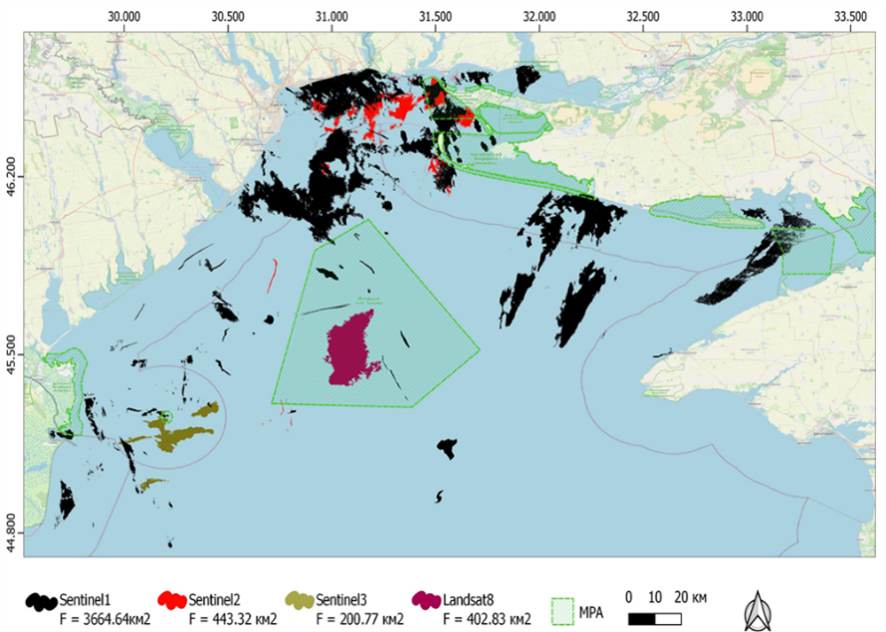
Yet as the ecosystem shrank, extraction became less profitable, and in 1996, just a few years after Ukraine’s independence, scientists added a Phyllophora species to the Red Book for protection. The following year the agar harvests stopped. New international agreements like the Danube River Protection Convention and Carpathian Convention guided cleanups of the many rivers that run into the Black Sea. Zernov’s Phyllophora Field became a marine protected area in 2008, and the Small Phyllophora Field followed in 2012. The red seaweed ecosystems began to recover.
When scientists see what’s happening in the Phyllophora fields, “we can understand the whole ecological state for the Black Sea,” says Minicheva. The recovery of these fields was good news for the entire region.
A Recovery Interrupted
“But this beautiful period for the whole Black Sea ecosystem, for Zernov’s Phyllophora Field, finished after the start of 2022,” says Minicheva. “Everything changed.”
Some areas, like the Small Phyllophora Field, had been cut off from research and conservation since 2014. “But of course, with the beginning of the full-scale war and the active hostilities in the northern part of the Black Sea, the impacts are much bigger and the scale is much higher,” says Sadogurska.
Scientists lost access to both fields. Russia blocked ports, destroyed coastal infrastructure, and littered the sea with dangerous floating mines.
“One of the threats from the Russian invasion in Ukraine is the lack of this long-term monitoring and lack of this data on the state marine ecosystems in the northwestern part of the Black Sea,” says Sadogurska.
Ukrainian scientists are doing their best to fill those gaps. “We can compensate using remote technology and take information from satellites,” says Minicheva. The scientists have developed intensive satellite use since the war’s start. What they can see on the water’s surface suggests impacts to the seaweed fields far below.
Through satellite images they’ve seen a military ship shooting near an important Phyllophora research station. They’ve tracked the sheen of oil from sunken aircraft and warships like the Russian missile cruiser Moskva, which sank in Zernov’s Phyllophora Field. “We make special assessments of how much of the Phyllophora field is covered by oil spills,” says Minicheva.
And perhaps worst of all, they’ve watched destructive floodwaters flow into the Black Sea after Russia attacked the Kakhovka Dam, draining a massive reservoir. It was “all freshwater, with garbage, with pollution, coming in the northwest part,” says Minicheva.
“One month after destroying the Kakhovka Dam, the situation was critical,” she recalls.
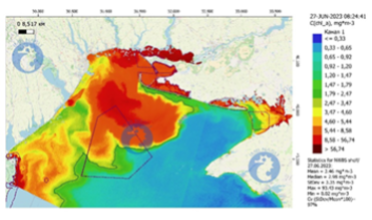
Yet just a few months later, the satellites showed a more promising picture. The pollution had sparked a bloom of algae that fed on the pollutants. While the Phyllophora fields face lasting damage from the disaster, the algae helped by cleaning up the environment.
Although algae blooms can also have risks, like toxicity to humans and blocking sunlight from other species, Minicheva emphasizes that in this case they are “an excellent nature mechanism, which [brings] back the system to the start position.”
Educated Guesswork
Other threats are harder to measure from afar. Damaged ships have floated ablaze through the northern Black Sea, polluting both water and air. Ballast water from military ships have a long history of introducing unexpected species. For example, in 1982, ballast water from U.S. ships brought an Atlantic comb jelly to the Black Sea, which severely threw off the ecological balance as it ate almost all the zooplankton. And sunken planes and ships from this war may leak pollutants for decades (vessels downed during World War II are still causing ecological harm).
Some effects may never be fully known.
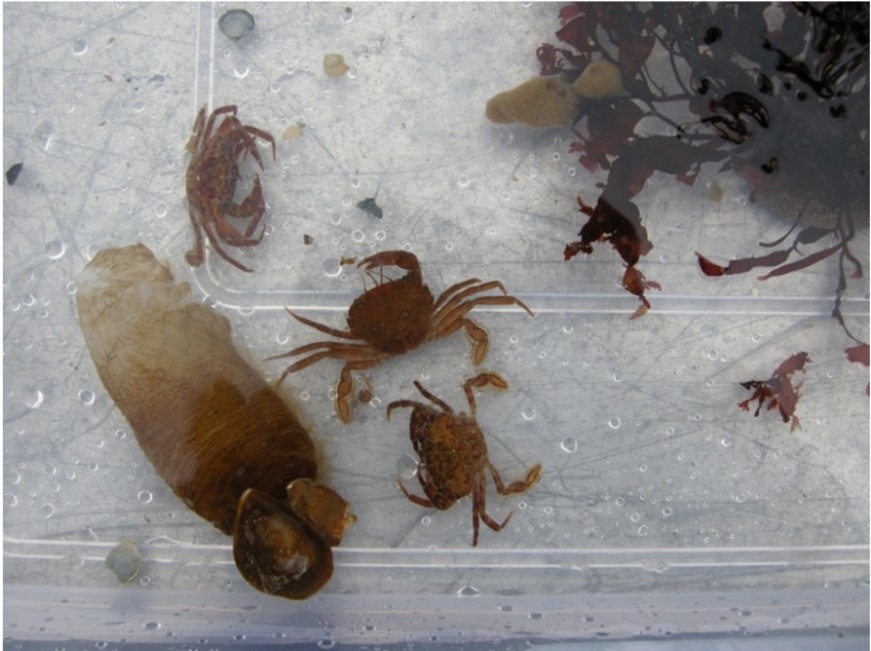
“It’s often quite hard to estimate the impact of war if you were not present in this specific place when something happened and you come there sometime after,” says Sadogurska.
Still, extrapolating from one ecosystem can help scientists understand another.
“It’s unsafe to go to the marine coastal areas, due to the mines,” says Sadogurska. “But the lagoons, they are safe and are open, and we can use them as kind of a laboratory for science to collect some samples, to understand some impacts, to continue some of our work.”
For example, scientists observing Ukrainian freshwater ecosystems found that underwater explosions ruptured the swim bladders of fish, causing mass die-offs. Explosions in or near the Phyllophora fields have likely killed many fish there, too. Yet without in-person research, the true status of the Phyllophora fields, deep under the surface of the Black Sea, remains unknown.
The Future of Phyllophora
As the war rages on, scientists are planning for an eventual post-hostility future by “trying to put in place the policies and approaches which will allow for better conservation of these ecosystems,” says Sadogurska.
She’s among those working to add ecosystems including the Phyllophora fields to the Emerald Network, a European system of protected areas for non-European Union countries.
“Since we cannot access many of our territories and water areas due to the occupation and the ongoing war, we still have a lot of data related to their biodiversity, and we can push for creation of the protected areas on these territories even if they are currently under occupation,” Sadogurska says.
After Ukraine’s accession to the EU, the Emerald Network sites will join the EU’s Natura 2000 network of protected places. Experts then expect to have access to additional funding for conserving and restoring these areas.
For now remote monitoring of the Phyllophora fields continues, while researchers plan how they’ll study the war’s damage in person once it ends.
“There is still a lot of work to do,” Sadogurska says.
To Ukrainian researchers, this fight to protect the red seaweed fields is about science, and much more.
“For me as a scientist, it’s personally really hurtful to see the impact of war specifically on the areas where I worked,” says Sadogurska.
“Morality and ecology are two things that go very close together,” says Minicheva.

Previously in The Revelator:
20 Endangered Species at Risk in Ukraine

